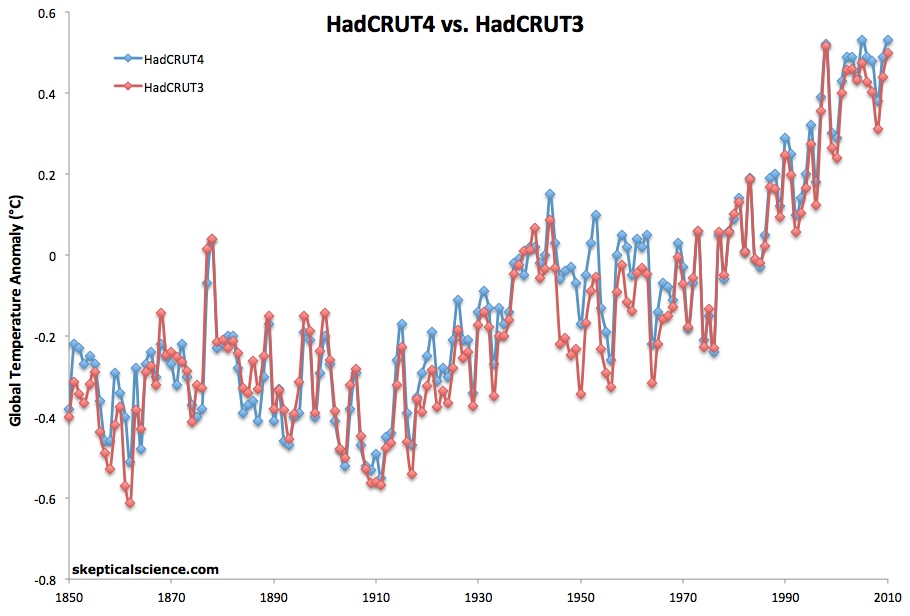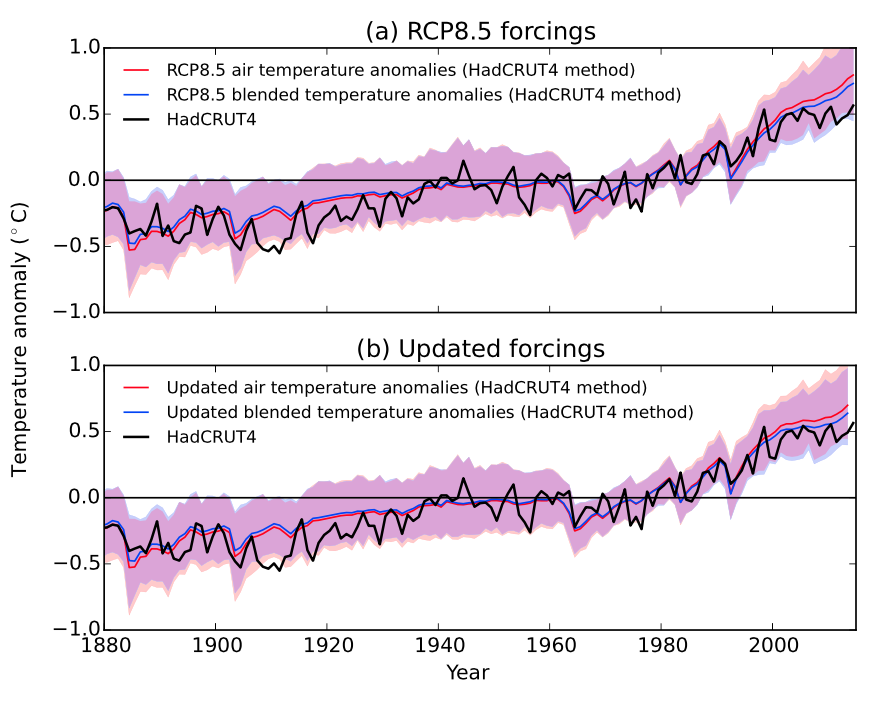2 August 2015
New Paper Shows Global Climate Model Errors are Significantly Less Than Thought
Posted by Dan Satterfield

A group of scientists have matched the output of climate models to the way the Earth’s temperature record is constructed, and found a surprising result. The climate models are doing an even better job at predicting the Earth’s temperature than was thought. Image from Skeptical Science.
Imagine I look at a numerical weather model forecast that predicts the temp. at 5 PM the next day, will be 30C where I live. The next day, I go out at 5 PM and measure 29C instead. Was the model wrong? Probably, since models are just numerical representations of the atmosphere with some processes explicitly predicted, while other processes (like clouds) approximated from other model variables. There is also another possibility that is also just as likely. My temperature measurement may be in error. My thermometer could be off, or I could be in a cooler part of town, and a host of other possibilities. Perhaps the model forecast is not off by 1C, but will be much less if I look more closely at what IT is predicting, versus what I am measuring.
Now, imagine you are running a global climate model, and it shows the atmosphere warming a bit faster than you observe. The difference is very small, but you want to improve the model, so you ask yourself much the same question: Is the way I’m comparing what the model forecasted and what I measured wrong? A group of scientists (from a rather impressive range of institutions) have asked just this same question and the answer seems to be that we have been comparing apples to oranges!
In this case, they took the forecasts of surface air temperature from the global climate models, and tried to adjust that more closely to the way the global temperature record is constructed. There are actually several reconstructions, with NASA, NOAA, and the UK Met Office/Hadley Center reconstructions being the most well-known. Now, these reconstructions are not static, since they are constantly being improved, and uncertainty in the measurements reduced. The Hadley Center current reconstruction is labeled HADCRUT4, and this new paper in the AGU Journal Geophysical Research Letters looks at climate model output compared to this data set.
What did they find?
Here’s the abstract, and it’s quite succinct:
Global mean temperatures from climate model simulations are typically calculated using surface air temperatures, while the corresponding observations are based on a blend of air and sea surface temperatures. This work quantifies a systematic bias in model-observation comparisons arising from differential warming rates between sea surface temperatures and surface air temperatures over oceans. A further bias arises from the treatment of temperatures in regions where the sea ice boundary has changed. Applying the methodology of the HadCRUT4 record to climate model temperature fields accounts for 38% of the discrepancy in trend between models and observations over the period 1975-2014.
The reconstructed HADCRUT4 data uses sea surface temps. to estimate air temperatures over the oceans for reasons due to measurement issues in the data record, but when output from GCM’s is compared with it, they are usually using air temps. near the surface. To state it more clearly even, here is a quote from the paper:
“A true like-with-like comparison would involve blending the air and sea temperature fields from the models in a manner consistent with the observational records.” A known mis-match when comparing model air temp. and the data set is due to air temps. over ice, so blending the output of the models in such a way to better capture all these differences seems like a good idea. Michael Mann, one of the papers co-authors said the ice issue alone is a significant factor. Here is a graph (from the paper) showing the difference after they produced a more realistic blend of model data to compare with the HADCRUT4.

From: Cowtan, K., Z. Hausfather, E. Hawkins, P. Jacobs, M. E. Mann, S. K. Miller, B. A. Steinman, M. B. Stolpe, and R. G. Way (2015), Robust comparison of climate models with observations using blended land air and ocean sea surface temperatures, Geophys. Res. Lett., 42, doi:10.1002/2015GL064888.
The result is 38% of the difference between the forecast, and what we observe seems likely to be the result of how we have compared the model forecasts with the temperature record we have constructed! The authors end the paper with suggestions on how to better approach how model output is compared with actual air temperature in the future, and I have a feeling this paper is going to get a lot of media notice in the coming days.
One last thing to ponder here. We won’t know how accurate the predictions of the Earth’s temperature in 85 years will be for another 85 years, but we can ask the model to predict the temperature from 1880-2010, and see how it does. Look at the match in the graph above. That is pretty amazing, no? Even without the corrections on this paper, the forecasts were in the cone of uncertainty.
These same models say that if we continue to burn fossil fuels, the planet’s temp. will soar in 85 years to a level that will profoundly change the climate for hundreds of years, and cause centuries of rapid sea level rise, as the ice in Greenland and Antarctica melts. Now you know why so many climate experts are saying that people just do not seem to get it.
We are truly playing with fire and ice.
That may be changing though, because the Washington Post on my coffee table this morning has front page news about a coming announcement from the Obama administration tomorrow about how we generate our power, and there is a video posted on White House social media about it as well. Already, politicians are saying that the administration has declared a “war on coal”.
The science has been saying that we need to do that for 25 years.


 Dan Satterfield has worked as an on air meteorologist for 32 years in Oklahoma, Florida and Alabama. Forecasting weather is Dan's job, but all of Earth Science is his passion. This journal is where Dan writes about things he has too little time for on air. Dan blogs about peer-reviewed Earth science for Junior High level audiences and up.
Dan Satterfield has worked as an on air meteorologist for 32 years in Oklahoma, Florida and Alabama. Forecasting weather is Dan's job, but all of Earth Science is his passion. This journal is where Dan writes about things he has too little time for on air. Dan blogs about peer-reviewed Earth science for Junior High level audiences and up.